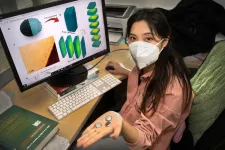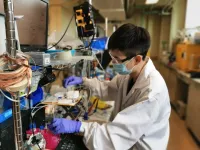(Press-News.org) UPTON, NY--A team of researchers led by chemists at the U.S. Department of Energy's (DOE) Brookhaven National Laboratory has studied an elusive property in cathode materials, called a valence gradient, to understand its effect on battery performance. The findings, published in Nature Communications, demonstrated that the valence gradient can serve as a new approach for stabilizing the structure of high-nickel-content cathodes against degradation and safety issues.
High-nickel-content cathodes have captured the attention of scientists for their high capacity, a chemical property that could power electric vehicles over much longer distances than current batteries support. Unfortunately, the high nickel content also causes these cathode materials to degrade more quickly, creating cracks and stability issues as the battery cycles.
In search of solutions to these structural problems, scientists have synthesized materials made with a nickel concentration gradient, in which the concentration of nickel gradually changes from the surface of the material to its center, or the bulk. These materials have exhibited greatly enhanced stability, but scientists have not been able to determine if the concentration gradient alone was responsible for the improvements. The concentration gradient has traditionally been inseparable from another effect called the valence gradient, or a gradual change in nickel's oxidation state from the surface of the material to the bulk.
In the new study led by Brookhaven Lab, chemists at DOE's Argonne National Laboratory synthesized a unique material that isolated the valence gradient from the concentration gradient.
"We used a very unique material that included a nickel valence gradient without a nickel concentration gradient," said Brookhaven chemist Ruoqian Lin, first author of the study. "The concentration of all three transition metals in the cathode material was the same from the surface to the bulk, but the oxidation state of nickel changed. We obtained these properties by controlling the material's atmosphere and calcination time during synthesis. With sufficient calcination time, the stronger bond strength between manganese and oxygen promotes the movement of oxygen into the material's core while maintaining a Ni2+ oxidation state for nickel at the surface, forming the valence gradient."
Once the chemists successfully synthesized a material with an isolated valence gradient, the Brookhaven researchers then studied its performance using two DOE Office of Science user facilities at Brookhaven Lab--the National Synchrotron Light Source II (NSLS-II) and the Center for Functional Nanomaterials (CFN).
At NSLS-II, an ultrabright x-ray light source, the team leveraged two cutting-edge experimental stations, the Hard X-ray Nanoprobe (HXN) beamline and the Full Field X-ray Imaging (FXI) beamline. By combining the capabilities of both beamlines, the researchers were able to visualize the atomic-scale structure and chemical makeup of their sample in 3-D after the battery operated over multiple cycles.
"Both beamlines have world-leading capabilities. You can't do this research anywhere else," said Yong Chu, leader of the imaging and microscopy program at NSLS-II and lead beamline scientist at HXN. "FXI is the fastest nanoscale beamline in the world; it's about ten times faster than any other competitor. HXN is much slower, but it's much more sensitive--it's the highest resolution x-ray imaging beamline in the world."
HXN beamline scientist Xiaojing Huang added, "At HXN, we routinely run measurements in multimodality mode, which means we collect multiple signals simultaneously. In this study, we used a fluorescence signal and a phytography signal to reconstruct a 3-D model of the sample at the nanoscale. The florescence channel provided the elemental distribution, confirming the sample's composition and uniformity. The phytography channel provided high-resolution structural information, revealing any microcracks in the sample."
Meanwhile at FXI, "the beamline showed how the valence gradient existed in this material. And because we conducted full-frame imaging at a very high data acquisition rate, we were able to study many regions and increase the statistical reliability of the study," Lin said.
At the CFN Electron Microscopy Facility, the researchers used an advanced transmission electron microscope (TEM) to visualize the sample with ultrahigh resolution. Compared to the x-ray studies, the TEM can only probe a much smaller area of the sample and is therefore less statistically reliable across the whole sample, but in turn, the data are far more detailed and visually intuitive.
By combining the data collected across all of the different facilities, the researchers were able to confirm the valence gradient played a critical role in battery performance. The valence gradient "hid" the more capacitive but less stable nickel regions in the center of the material, exposing only the more structurally sound nickel at the surface. This important arrangement suppressed the formation of cracks.
The researchers say this work highlights the positive impact concentration gradient materials can have on battery performance while offering a new, complementary approach to stabilize high-nickel-content cathode materials through the valence gradient.
"These findings give us very important guidance for future novel material synthesis and design of cathode materials, which we will apply in our studies going forward," Lin said.
INFORMATION:
This study was a collaborative effort among several universities and DOE laboratories, including research teams involved in DOE's Battery500 Consortium, which aims to make lithium-metal battery cells with an energy density of 500 watt-hours per kilogram, more than double the energy density of today's state-of-the-art batteries. The research was supported by DOE's Office of Energy Efficiency and Renewable Energy, Vehicle Technologies Office and DOE's Office of Science. Additional x-ray experiments were carried out at the Advanced Light Source (ALS) and the Advanced Photon Source (APS), two DOE Office of Science user facilities that are located at DOE's Lawrence Berkeley National Laboratory and Argonne National Laboratory, respectively. Operations at NSLS-II, CFN, ALS, and APS are supported by the Office of Science.
Brookhaven National Laboratory is supported by the U.S. Department of Energy's Office of Science. The Office of Science is the single largest supporter of basic research in the physical sciences in the United States and is working to address some of the most pressing challenges of our time. For more information, visit https://energy.gov/science.
Follow @BrookhavenLab on Twitter or find us on Facebook.
The South Pole and the rest of East Antarctica is cold now and was even more frigid during the most recent ice age around 20,000 years ago -- but not quite as cold as previously believed.
University of Washington glaciologists are co-authors on two papers that analyzed Antarctic ice cores to understand the continent's air temperatures during the most recent glacial period. The results help understand how the region behaves during a major climate transition.
In one paper, an international team of researchers, including three at the UW, analyzed seven ice cores from across West and East Antarctica. The results published June 3 in Science show warmer ice age temperatures in the eastern part of the continent.
The team ...
Scientists have gained the best view yet of the brightest explosions in the universe: A specialised observatory in Namibia has recorded the most energetic radiation and longest gamma-ray afterglow of a so-called gamma-ray burst (GRB) to date. The observations with the High Energy Stereoscopic System (H.E.S.S.) challenge the established idea of how gamma-rays are produced in these colossal stellar explosions which are the birth cries of black holes, as the international team reports in the journal Science.
"Gamma-ray bursts are bright X-ray and gamma-ray flashes observed in the sky, emitted by distant extragalactic sources," explains DESY scientist Sylvia Zhu, one of the authors of the ...
The biggest shark attack in history did not involve humans.
A new study by Earth scientists from Yale and the College of the Atlantic has turned up a massive die-off of sharks roughly 19 million years ago. It came at a period in history when there were more than 10 times more sharks patrolling the world's oceans than there are today.
For now, researchers don't know the cause of the shark die-off.
"We happened upon this extinction almost by accident," said Elizabeth Sibert, a Hutchinson postdoctoral associate in Yale's Department of Earth and Planetary Sciences and ...
Scientists have developed the first cells that can construct artificial polymers from building blocks that are not found in nature, by following instructions the researchers encoded in their genes.
The study, led by scientists from the Medical Research Council (MRC) Laboratory of Molecular Biology, in Cambridge, UK, also found the synthetic genome made the bacteria entirely resistant to infection by viruses.
The scientists say their research could lead to the development of new polymers - large molecules made of many repeating units, such as proteins, plastics, and many drugs including antibiotics - and make it easier to ...
Hydrogels are polymer materials made mostly from water. They can be used in a wide range of medical and other applications. However, previous incarnations of the materials suffered from repeated mechanical stress and would easily become deformed. A novel crystal that can reversibly form and deform, allows hydrogels to rapidly recover from mechanical stress. This opens up the use of such biocompatible materials in the field of artificial joints and ligaments.
Many of us suffer the occasional sports injury or experience some kind of pain relating to joints and ligaments at some point in our lives. ...
Researchers from University of Toronto Engineering have developed an improved electrochemical system that raises the value of captured CO2 by converting more of it into valuable products than ever before.
The International Energy Agency recently cited carbon capture and storage as one of the strategies that can help keep global emissions low enough to limit global warming to 1.5 C by 2050. But captured carbon currently has little economic value, reducing the incentive for companies to invest in this technology.
A University of Toronto Engineering team led by Professor Ted Sargent is addressing this challenge by designing advanced electrolyzers that use electricity to convert captured CO2 into the petrochemical building blocks of common everyday materials, ...
An engineering researcher from the University of Sydney, in collaboration with a team at the University of Toronto, has developed an electrochemical system that coverts a greater amount of CO2 into valuable products.
The International Energy Agency recently cited carbon capture and storage as a strategy that can help keep global emissions low enough to limit global warming to 1.5°C by 2050. However, captured carbon currently has little economic value, reducing the incentive for companies to invest in this technology.
The team of researchers has addressed this challenge by designing advanced electrolysers - machines using electricity to convert captured CO2, plus water, into the building blocks of common everyday materials, ...
Astronomers have measured very-high-energy gamma rays coming from the aftermath of a gamma ray burst - an enormously energetic explosion of a star in another galaxy. The results shine light on these immensely powerful but little-understood cosmic events, and challenge standard models of how gamma ray bursts radiate light during their afterglow phases. As a dying massive star enters its final death throes, its core begins to collapse, and then explodes as a supernova. Some types of supernovae generate jets of particles moving at close to the speed of light; if the jet is pointed directly towards Earth it can be observed as a burst of gamma ray radiation that lasts several seconds. These gamma ray bursts are sometimes ...
The widespread non-pharmaceutical interventions implemented to mitigate the transmission of COVID-19 have led to drastic reductions in the annual circulation patterns of other endemic respiratory viruses, including influenza and the common cold. How this will affect future transmission patterns of these pathogens remains unknown. In a Perspective, Gabriela Gomez and colleagues discuss what could be expected concerning the epidemiology of common respiratory viruses once the COVID-19 pandemic subsides and argue that expanded genomic and clinical surveillance is needed to best understand the spread of respiratory viruses in a post-COVID-19 world. "Currently, the emergency response to COVID-19 is a global priority, but preparation for future threats ...
Nineteen million years ago, sharks nearly disappeared from Earth's oceans, according to a new study, which provides evidence for a previously unknown mass ocean extinction event. Sharks as a species never recovered from this, the study's authors say; their diversity today represents only a fraction of what it once was, the data suggest. Much of what is known about ancient ocean ecosystems is derived from rock and fossil records, which are generally limited to shallow-water deposits and provide only a small glimpse into the ocean-wide history of marine ...



